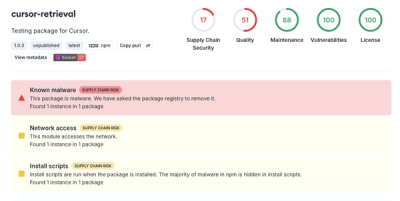
Security News
The Risks of Misguided Research in Supply Chain Security
Snyk's use of malicious npm packages for research raises ethical concerns, highlighting risks in public deployment, data exfiltration, and unauthorized testing.
@blimmer/cdk-static-wordpress
Advanced tools
Generate a static site from Wordpress (via WP2Static) using AWS CDK
The goal of this project is to make it easy to deploy a static website, generated by Wordpress as simple and cost-effective as possible.
It's largely inspired by TechToSpeech/terraform-aws-serverless-static-wordpress, but uses AWS CDK instead of Terraform.
It creates the infrastructure to launch a temporary, transient Wordpress container. You then log in and customize it like any Wordpress site, and finally publish it as a static site fronted by a global CloudFront CDN and S3 Origin. When you’re done you shut down the Wordpress container and it costs you almost nothing.
WP2Static is used to generate the static site from the Wordpress container.
⚠️ This project is archived and no longer being maintained. ⚠️
This was a fun side project, but recent external changes have made it challenging to run Wordpress in a cost-efficient manner.
The deprecation of AWS RDS Serverless v1 means that AWS no longer offers a managed MySQL database instance that can scale to 0 when not in use. I considered a few ideas to work around this, but ultimately I decided that the workarounds wouldn't match my personal use case.
WP2Static is quite slow, and many issues go unaddressed. It seems like they're actively pushing their hosted / paid solution, which is fine, but it means that the OSS version doesn't receive much attention.
I couldn't find a good solution to store images and other media files in a cost-effective manner. Wordpress stores uploads in EFS, which is quite expensive for this use case. My primary use case was to host a travel blog with lots of high-quality images, so this was a significant cost factor for me.
Wordpress is a pain, in general. It's really a beast to maintain. I broke the docker image several times trying to keep the PHP / Apache dependencies up-to-date. I'm not a Wordpress expert, so I found it challenging to debug.
For these reasons, I've decided to no longer maintain this package. If anyone would like to pick up the torch and continue maintaining this project, please feel free to fork it!
If you like the idea of this package, you could keep an eye on TechToSpeech/terraform-aws-serverless-static-wordpress. That project was the original inspiration for this CDK rewrite. However, that repository still uses Aurora Serverless V1 and hasn't received much attention lately (at time of writing - May 2024, it hasn't been updated in > 2 years).
Consider a tool designed specifically for static site generation. For me, I migrated my project to use Astro. I used lonekorean/wordpress-export-to-markdown to export my content from Wordpress to Markdown, and then I manually copied the exported files into my Astro project. It required a bit of manual translation, but it worked great for my use case. Astro is very fast compared to WP2Static (for my use case > 100x faster) and is designed for this use case. You can also use Astro with many other CMS tools if you don't want to write Markdown.
I've been keeping my eyes on Webiny, a truly serverless CMS tool. This didn't quite work for my use case, but it might work for you.
If you'd like to take a final backup, you can use a tool like Updraft Plus. This will create a portable backup you can use to restore your Wordpress instance somewhere else (e.g., Lightsail, a hosted Wordpress provider, etc.).
Then, destroy the resources created CDK Static Wordpress by running cdk destroy. This will remove all the resources
associated with the project.
Install the construct:
yarn add @blimmer/cdk-static-wordpress
# or
npm i --save @blimmer/cdk-static-wordpress
Instantiate a StaticWordpress instance a Stack:
import { StaticWordpress } from "@blimmer/cdk-static-wordpress";
import { Stack, StackProps } from "aws-cdk-lib";
import { HostedZone } from "aws-cdk-lib/aws-route53";
import { Construct } from "constructs";
export class StaticWordpressStack extends Stack {
constructor(scope: Construct, id: string, props?: StackProps) {
super(scope, id, props);
// You can create or import a hosted zone
// See https://docs.aws.amazon.com/cdk/api/v2/docs/aws-cdk-lib.aws_route53.HostedZone.html
const exampleHostedZone = new HostedZone(this, "ExampleHostedZone", {
zoneName: "example.com",
});
new StaticWordpress(this, "StaticWordpress", {
fullyQualifiedSiteName: "blog.example.com",
hostedZone: exampleHostedZone,
wordpressAdminProps: {
email: "me@example.com",
},
});
}
}
Deploy with the cdk deploy command
Once the deployment completes, visit the Wordpress console at admin-<fullyQualifiedSiteName>. E.g., if your static
site is blog.example.com, visit admin-blog.example.com/wp-admin. The default password for the wordpress user is
changeme (please change it :smile:).
Customize Wordpress as you see fit, create posts, etc.
When you're ready to deploy your static site, trigger WP2Static.
Visit your static site (e.g., blog.example.com) once WP2Static completes.
(optional) Shut down the Wordpress container to save money.
new StaticWordpress(this, "StaticWordpress", {
fullyQualifiedSiteName: "blog.example.com",
hostedZone: exampleHostedZone,
wordpressAdminProps: {
email: "me@example.com",
run: false, // <-- Shut down the container after deployment
},
});
TODO
This construct provides escape hatches, to allow you to customize the underlying infrastructure if you need to. This is a big benefit of using CDK over Terraform (where every customizable property must be manually exposed as a variable).
Look for *Overrides in the API docs for customization options. But, be warned, we allow overriding almost
everything, so you can easily produce invalid infrastructure if you don't know what you're doing.
FAQs
Generate a static site from Wordpress (via WP2Static) using AWS CDK
The npm package @blimmer/cdk-static-wordpress receives a total of 0 weekly downloads. As such, @blimmer/cdk-static-wordpress popularity was classified as not popular.
We found that @blimmer/cdk-static-wordpress demonstrated a healthy version release cadence and project activity because the last version was released less than a year ago. It has 1 open source maintainer collaborating on the project.
Did you know?

Socket for GitHub automatically highlights issues in each pull request and monitors the health of all your open source dependencies. Discover the contents of your packages and block harmful activity before you install or update your dependencies.

Security News
Snyk's use of malicious npm packages for research raises ethical concerns, highlighting risks in public deployment, data exfiltration, and unauthorized testing.

Research
Security News
Socket researchers found several malicious npm packages typosquatting Chalk and Chokidar, targeting Node.js developers with kill switches and data theft.

Security News
pnpm 10 blocks lifecycle scripts by default to improve security, addressing supply chain attack risks but sparking debate over compatibility and workflow changes.